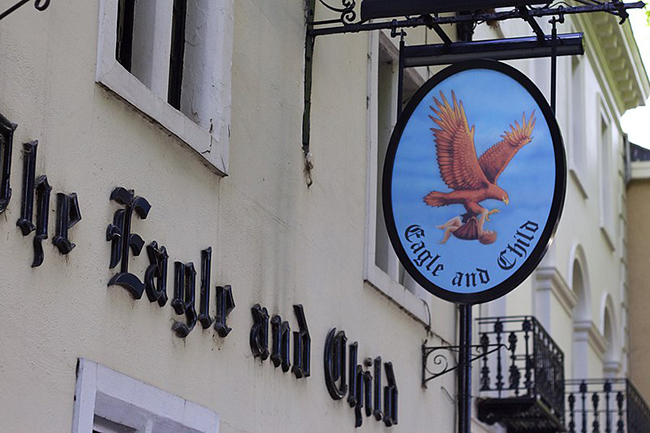C.S. Lewis and J.R.R. Tolkien. Narnia and Middle Earth. The two Oxford professors and their two fantasy worlds are inextricably linked, and that may even extend to The Rings of Power show.
In the second episode, we get a quick glance at some stone carvings outside the village of Tirharad in the Southlands at 44:40. One of those bears a striking resemblance to a location very important to Tolkien, Lewis and their famous stories. Does that carving give us a hint at the relationship that made The Lord of the Rings and the entirety of Middle Earth possible?
Friendship of Lewis and Tolkien
Lewis and Tolkien first met in May 1926. While initially wary of each other, they eventually bonded over a shared love of Norse mythology. Their friendship grew until Tolkien explained to Lewis how Christianity was the “True Myth” on a late night stroll around Addison’s Walk.
The two continued to encourage each other in their work at Oxford, their now-shared faith, and their literary ideas. Because they disliked so much of the fiction at their time, the two made a pact to write books that they’d want to read. Tolkien was supposed to write a time-travel series and Lewis a space-travel one. Tolkien was never completed, but Lewis quickly wrote Out of the Silent Planet and eventually his space trilogy.
The two continued to discuss their other ideas, but this time for fantasy. Again, Lewis quickly wrote The Chronicles of Narnia, while Tolkien struggled to overcome his perfectionism to craft his work.
Prediction is dangerous: but "The Hobbit" may well prove a classic. — C.S. Lewis, 1937 Click To TweetStill Tolkien kept working, showing Lewis the beginning phases of his new book in 1933. Eventually, through much encouraging and effusive praise from Lewis along the way, Tolkien would publish The Hobbit in 1937. Lewis would write a glowing review, which concluded with the prophetic line: “Prediction is dangerous: but The Hobbit may well prove a classic.”
Tolkien continued to read passages of his next work to Lewis, who was just as enthusiastic as before. Finally in 1949, Tolkien sent his first completed version of The Lord of the Rings to Lewis. After finishing the trilogy, Lewis responded by saying, “I have drained the rich cup and satisfied a long thirst.” He said the work was “almost unequalled in the whole range of narrative art known to me.”
For his part, Tolkien credited Lewis for the completion of the fantasy epic. In a letter after the first reviews of The Lord of the Rings, Tolkien shares how Lewis was concerned his praise of the books may backfire.
But for [C.S. Lewis'] interest and unceasing eagerness for more I should never have brought "The Lord of the Rings" to a conclusion. — J.R.R. Tolkien, 1965 Click To Tweet[Lewis] warned me long ago that his support might do me as much harm as good. I did not take it seriously, though in any case I should not have wished other than to be associated with him — since only by his support and friendship did I ever struggle to the end of the labour.
J.R.R. Tolkien, letter 149, to Rayner Unwin on September 9, 1954
After Lewis’ death, in reflecting on his friend and the contribution he made to Middle Earth, Tolkien again made it clear that there would be no Middle Earth without his friend.
The unpayable debt that I owe to him was not ‘influence’ as it is ordinarily understood, but sheer encouragement. He was for long my only audience. Only from him did I ever get the idea that my ‘stuff’ could be more than a private hobby. But for his interest and unceasing eagerness for more I should never have brought [The Lord of the Rings] to a conclusion.
J.R.R. Tolkien, letter 276, to Dick Plotz on September 12, 1965
Rings of Power connection
So how did The Rings of Power offer a tribute to this famous friendship with this stone carving?

The Oxford pub where Lewis, Tolkien and other members of their group, the Inklings, was called “The Eagle and Child” (or “The Bird and the Baby” as they nicknamed it). It’s where they would read aloud their works and have the others comment on it. Inside that pub, Tolkien would share of hobbits and rings. Lewis would read of a wardrobe and a great lion.
The stone carving from The Rings of Power looks suspiciously close to the sign outside the pub with the eagle carrying the child below him. According to Tolkien scholar Sara Brown on “The Rings of Power Wrap-Up” podcast, the resemblance is deliberate and was a nod to the pub and the friendship between Lewis and Tolkien. She said the art director wanted to hint at Inklings and their famous gathering spot.
Here are the two images of an eagle carrying a child side-by-side. While not identical, it does seem intentional and a subtle but great allusion to the friendship that help bring Middle Earth to life.

